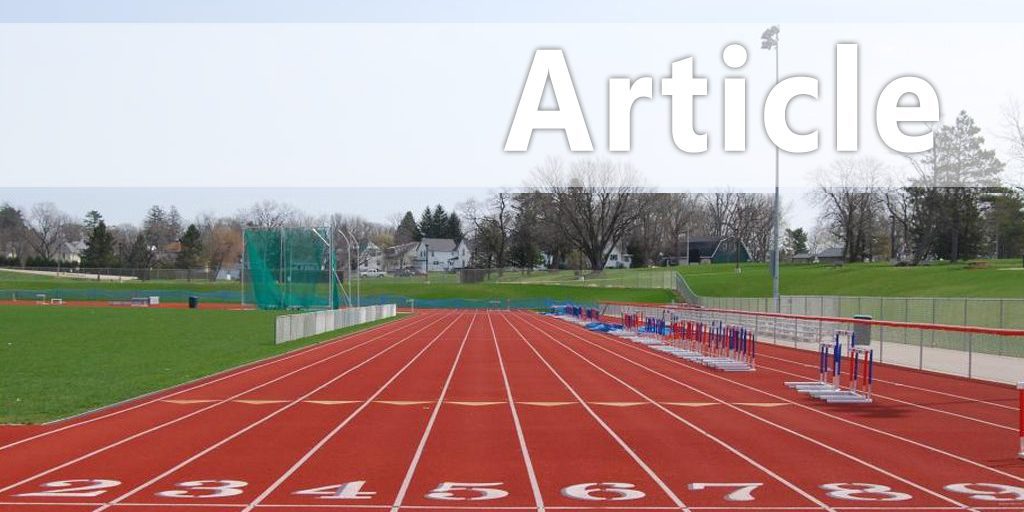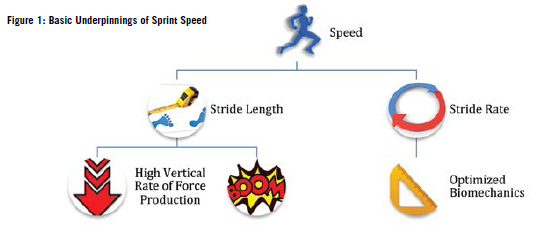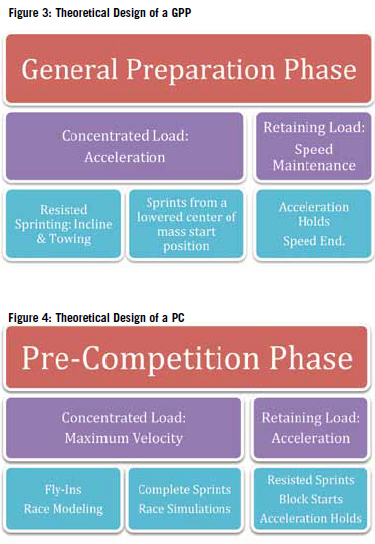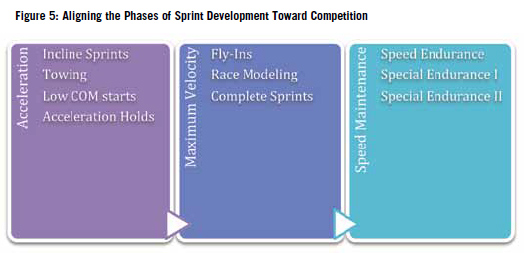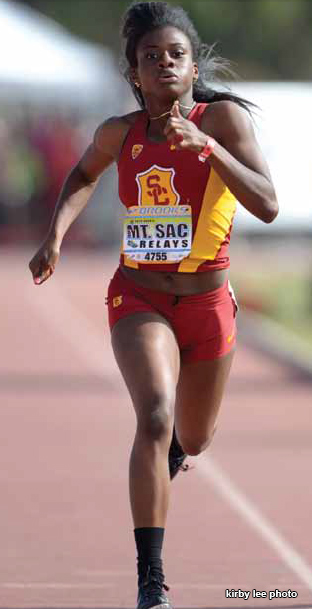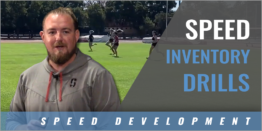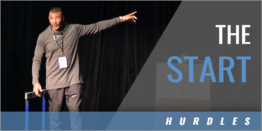|
The Nature of Speed By: Brad H. DeWeese EdD, Matt. L. Sams, MA, Joel H. Williams, Chris Bellon, MS Originally Published in Techniques Magazine - Provided by: USTFCCCA
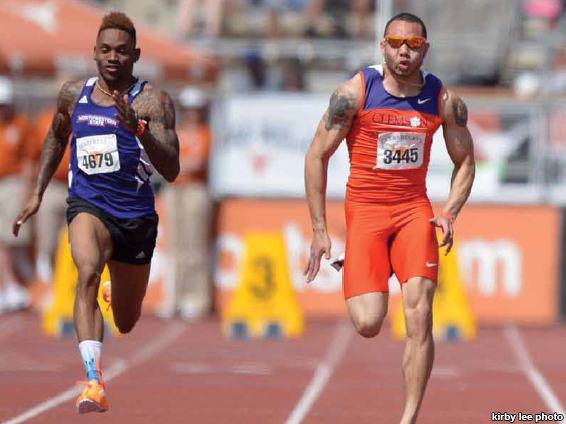
1.1 A BRIEF OVERVIEW ON PROGRAMMING TACTICS To adhere to the tenants of periodization, coaches can choose from a variety of programming methodologies. These programming tactics are similar in that most advocate a variation of the workload throughout the training year so that competitive abilities are maximized. However, a primary variance within programming "philosophies" is how fitness phases are blended. For instance, traditional programming advocates that periods of training should be developed to enhance singular components of fitness (work capacity, strength endurance, strength, power), ultimately building toward a major competition. Unfortunately, modern competition schedules prevent this long, deliberately unilateral development pattern. Evolving from this traditional model, Block programming attempts to address a more dense competition schedule by merging a traditional approach with briefer periods of "fitness phases." These blocks of time allow for the accumulation, transmutation and realization of a fitness parameter (Issurin, 2008). Similar to the traditional model, adopters of a block system develop specific components of fitness through the incorporation of "concentrated loads." Concentrated loads are defined as short periods of time (typically four weeks) where one training quality is emphasized. In other words, most of the training time is spent on improving that lone parameter (for instance, acceleration). These segmented blocks of priority are then aligned in a complementary manner in hopes of bolstering future periods of time as competition nears. These blocks could then be cycled as an athlete prepares for a subsequent competition. Building from block, an advanced method of programming aims to enhance competitive ability through a more strategic addition and retention of fitness phases. Conjugate Sequential programming parallels block programming with the utilization of concentrated loads, but further supports the retention of previously developed fitness qualities through the adoption of "retaining loads." These retaining loads are established to either maintain the previous block's agenda or introduce a future block's concentrated load. For example, while a coach may concentrate the load on the development of maximum velocity, they may choose to maintain accelerative abilities with reduced volumes. In addition, a coach may prescribe minimal practice volumes to introduce top-speed endurance as a tertiary goal. These primary, secondary, and tertiary goals are established in such a way that the athlete is prepared for a dense competition schedule and is never too far removed from their optimal level of readiness. 1.2 CONJUGATE SEQUENTIAL PROGRAMMING FOR SPEED In contrast, short to long (S2L) refers to a training program that emphasizes shorter sprint distances at the beginning of the year, followed by a lengthening of repetition distances as the training season matures. Advocates of this system contend that speed cannot be built off of endurance; rather, maximum velocity is the result of a refined ability to accelerate. In other words, if an athlete can extend their acceleration zone, they may reach a higher terminal velocity later in the race. This higher top end speed would perhaps provide a greater point from which to "drop" at the onset of fatigue. From here, speed endurance may be optimally developed from the creation of a "speed reserve." The creation of a speed reserve suggests that successful longer-distance sprints, (200-400m competitive distances) are the result of running segments of the race at a velocity that is lower than the absolute maximum that could be achieved in a shorter race (60m-100m). In essence, the speed reserve is the culmination of a training process that first creates higher running velocities which then allow the athlete an opportunity to run longer sprint distances at a "submaximal" pace. This theory has gained support from Weyand and colleagues (2003, 2005) who have demonstrated that a reduction in sprint performance is not the result of cellular energy availability but is related to muscle force output, which diminishes as sprint distance increases.
2. FOUNDATIONAL CONSTRUCTS OF SPEED Within speed development, manipulations to GRF can be made through corrective changes in a sprinter's biomechanics. In other words, a sprinter's ability to properly direct force into the ground and subsequently receive and utilize reactive forces may be improved through training and optimized biomechanics. These biomechanical efficiencies can be enhanced and stabilized through the correct staging of speed and strength development strategies that seamlessly blend together through phase potentiation. As the late Charlie Francis stated, "Absolute strength, strength balance, and power must be developed before an athlete is able to get into the sprint position" (Francis, 1992). 2.1 FORCE DELIVERY During this abbreviated ground contact, better sprinters utilize higher force production to displace their body horizontally down the track, which can be described as their stride length. Interestingly enough, while leading to a greater stride length, this shortened stance phase and delivery of force into the ground does not result in a more rapid recovery of the swing leg in faster sprinters (Weyand et al., 2001). In fact, sprinters of both elite and average levels demonstrate similar rates of recovery between steps. Furthermore, due to large amounts of force production, elite sprinters tend to leave the ground quickly at toe off (Mann, 2013) preventing triple extension when observing the "back side mechanics." This quick, forceful foot-strike allows the legs to turnover more frequently. This biomechanical advantage results in a faster stride rate, which provides a more continuous opportunity to place force into the ground. While sprinters spend most of their time "above the track," the only way you can continue horizontal movement is through rapid, ballistic force production. Perhaps as a result of the longer stride length and shorter foot strike, better sprinters demonstrate greater hip flexion at the terminal portion of the recovery phase which may provide a greater angle of attack during the upcoming ground contact. This is commonly noted as the "higher knee" of what is termed the "front-side" portion of sprinting mechanics that provides the sprinter with a chance to properly direct vertical forces into the ground during foot contact (Mann 2013, Clark 2014). Moreover, coaches anecdotally describe the sounds of a fast sprinter's foot strike as sounding like a large "pop" or "bang" which supports the forceful impact as a result of optimized leg positioning. 3.0 MUSCULAR MECHANISMS Conceptually the SSC is important for sprinting as it underpins the spring-mass model (SMM). The SMM depicts sprinting as the result of a body mass bouncing along two springs (Blickhan, 1989, Dalleau et al., 1998, Dutton & Smith, 2002, Farley & Gonzalez, 1996). During a complete running cycle, one spring compresses and propels the sprinter's body forward. Simultaneously, the other spring swings forward in preparation for ground contact. Within an upright sprint, compression of the spring begins at foot strike, which results in horizontal braking forces. This sudden deceleration assists in propelling the swing leg forward in preparation for the following step. As the center of mass moves ahead of the stance foot, the sprinter enters the "mid-stance" phase. Within the SMM, the spring is compressed to the lowest point, which coincides with a lowered center of mass at mid-stance. Finally, the push-off (toe-off) segment of the stance phase describes the return of energy through the extension of the coiled spring. This return of force projects the sprinter forward into the next step. While the SSM provides a conceptual framework for highlighting the actions involved in upright sprinting, recent work suggests that there are limitations to the model's ability to describe the stance phase of elite sprinters. Specifically, Clark (2014) demonstrates that elite sprinters produce most of their vertical forces in the first half of a ground contact. In comparison, the stance phase of an average sprinter tends to yield a force curve more symmetrical in shape. Therefore, the ability to describe an elite sprinter's stance phase through the SSM is limited. The SSM can, however, continue to be used as a means of describing the relationship between the SSC, muscle stiffness and sprinting. 3.1 NEUROMUSCULAR STRUCTURE A sarcomere is the basic contractile unit that causes a muscle to shorten. Sarcomeres can be organized into "parallel" or "series" arrangement. While parallel sequencing favors force production, series arrangement affords greater shortening velocities. The status of sarcomere order is reflected in muscle pennation angle (PA) and fascicle length (FL). Greater PA is associated with a greater number of sarcomeres in parallel alignment, while longer FL reflects superior series alignment. In addition to a greater number of type II fibers (Costill et al., 1976), sprinters have been shown to possess greater FL (Abe, Kumagai, & Brechue et al., 2000) in comparison to other athletes. While these characteristics provide the high forces required for sprinting, they are ultimately underpinned by the neurological status of the athlete. More specifically, muscle fibers have been show to take on the qualities of their associated motor neuron (Buller, Eccles, & Eccles et al., 1960). Therefore, the characteristics of the neuron innervating a muscle fiber can be considered the primary determinant of a muscle's contractile capability. Contractile properties are influenced by the speed at which a neuron can transmit an electrical impulse to the muscle. Simply put, the faster a nerve can send a signal to the muscle, the faster and more frequently it can shorten. Neurological adaptations such as increased axon diameter, myelination and dendritic branching can enhance the nerve's ability to transmit an impulse to the muscle (Gardiner & Heckman, 1985, Gardiner, 1991). This improved transmission provides the athlete a greater capacity to express higher forces over a shorter period of time. As a result, a sprinter may be able to apply higher rates of force during the short ground contact times associated with elite speed.
4.0 RELATING THE NATURE OF SPEED TO PROGRAMMING Through an early emphasis on acceleration, a sprinter may improve the biomechanics and propulsive force-generating/ delivering mechanisms (neuromuscular architecture), which then serve to support and bolster their top speed. Once the athlete begins to dedicate training time for the maturity of maximum velocity, they will have benefited from the previous investment in force production, which may allow them to attain: preferred sprinting positions (shoulders stacked on hips, hips stacked on ankles) during the stance phase, optimized hip angles at the terminal portion of the recovery leg, the maintenance of a high hip height, a more proximal foot strike at initiation of stance phase, employment of the SSC and muscle stiffness, higher force production at the onset of stance phase, abbreviated ground contact time. From this point, the athlete can continue to improve their chances over longer competitive distances in subsequent periods of training by taking advantage of their newly developed speed reserve. The speed reserve, which is the result of a higher terminal velocity, allows the athlete to preserve sprint mechanics by running long sprints (speed endurance) at a prescribed pace. This training technique also provides benefit as it may prevent the unnecessary exposure to poor sprint mechanics and motoneuron control/ feedback. 4.1 BREAKING DOWN SPEED THROUGH AN ANNUAL PLAN Most often, all yearly plans begin with an emphasis on generalized development which serves to provide an athlete dedicated time to revisit and accumulate fitness characteristics that are reduced or compromised during the latter portion of competition and time off. The fitness characteristics that are typically accumulated during a general preparation phase (GPP) include but are not limited to: Once the athlete has met the objectives of the GPP, more specialized training is implemented, typically coinciding with an increase of intensity and task-specificity. For this article, the Special Preparation Period (SPP) can also be termed the Pre-Competitive Period (PC) as the primary aim is to merge the previous phase of general training with the need for competitive readiness. Training within this time frame continues to fine-tune the previously listed fitness characteristics through the prescription of retraining loads, but places larger emphasis on practice sessions that impart greater transfer of training effect to the competition schedule (Young, 2006). In general, the following areas are addressed within an SPP/PC: Ultimately, this training provides a catalyst for success within the Competition Period (CP). As the name denotes, this phase of training emphasizes practice schedules and exercise selections that further support and promote optimal readiness for race day. In addition, the volumes of training are generally reduced (in comparison to the entire annual plan) with an increase or maintenance of higher intensities. This is done with the premise that larger workloads may impede performance due to residual or lingering fatigue (McCaulley et al., 2009, Behm et al., 2002). Training tactics within the competitive period typically continue the efforts described within the SPP/PC but prioritize the following: While the aforementioned information regarding phasic development of fitness characteristics is beneficial for most athletes, special attention must be made for the refinement of speed. For this reason, an outline of speed enhancement using a short to long approach is provided below. 4.2 GENERAL PREPARATORY DEVELOPMENT OF SPEED Regardless of status, most sprinters begin the training year following a competitive period punctuated with a taper and a period of complete rest. This dramatic reduction in volume (and fitness) leads to a detrained state. Within sprinting, this detrained state could hypothetically include a reduction in the ability to produce high levels of force, power and movement economy. Acknowledging that maximum velocity is dependent on the ability to produce high rates of force through optimized biomechanics, a reinvestment in acceleration is justified. One method of re-establishing or improving an athlete's accelerative ability is incline sprinting. Through a subtle slope, a sprinter will be encouraged to produce greater propulsive forces in order to overcome the effects of the inclination, gravity and their body mass (Gottschall & Kram, 2005). This increased force production would come alongside possible improvements in biomechanics, including more aggressive arm action, knee drive and aggressive footsteps. Upon completion of a block of training emphasizing incline sprinting, a coach can begin to reintroduce "flat-ground" sprinting through the prescription of resisted sprints (towing), which mimic the incline. The similarity between incline sprinting and towing is a continued requirement to produce greater propulsive forces, body lean and aggressive arm and leg action. In addition, lowered starting positions (e.g. push-up starts) can be implemented. These exercises exaggerate the acceleration phase through a drastic reduction in an athlete's starting hip height. With the hips starting at a lower height, the athlete is placed in a position that not only necessitates high force production and leg drive, but also progressively introduces a longer "footfall". Gradually increasing the distance the foot travels prior to ground contact organically re-acclimates the athlete to flat-ground sprinting. In addition to the concentrated loading of acceleration, a sprint coach may prescribe low-volumes of slightly longer sprints in order to begin the development of speed endurance, which can be defined as a sprinting distance between 60-150m. This secondary aim could serve as a retaining load in order to set-up future training agendas. These agendas could include race-specific "pacing" and the development of a specialized work capacity.
4.3 SPECIAL PREPARATIOW PRE-COMPETITION Through the prescription of sprint distances that allow the athlete to express a taller posture, the improved force production should lead to a "higher and unwavering" hip position that sits directly under the shoulders and over the ankle at mid-stance. This stacked position provides ample room for the ideal hip flexion and resulting knee height that sets up a strong, vertical leg drive into the track. In addition, this hip and knee position provides the sprinter with clearance to plant the stance leg slightly ahead and underneath the hips. This optimal foot-strike pattern prevents an exaggerated deceleration and provides the sprinter an opportunity to take advantage of the SSC and SMM. In contrast, a weak sprinter will demonstrate higher decelerations immediately upon contact that may coincide with greater amplitude of the hips from step to step. As Dr. Ralph Mann describes, a weaker sprinter will vault into subsequent steps (Mann, 2014). While maximal-effort sprints covering a distance of 40-60 meters allow for this upright running position to occur, sprint coaches have utilized many training tactics to further an athlete's maximum velocity. Examples of this type of training include fly-in runs and race-modeling efforts. Fly-ins are a type of sprint that provide an athlete with a gradual build-up so that the athlete enters the "sprint" zone in an upright position and at or near their maximum velocity. Theoretically the sub-maximal buildup preserves force-generating ability through a limitation of neuromuscular fatigue. It should also be noted that the coach can control the velocities attained within the fly-zone by shortening or extending the build-up. Race modeling is an additional tool used to advance an athlete's maximum velocity. This type of training refers to a change in effort over a prescribed distance. A coach will create "speed change" zones and define them as "fast-easy-fast" or "fly-float-fly." Regardless of distance, the athlete is advised to "build speed, accelerate or press" during the "fast or fly" zones. Once the sprinter enters the "easy or float" zone they are cued to "maintain inertia" or continue sprinting with relaxed, flowing form. In the practical setting, coaches report that the disinhibition allows the athlete to hit higher velocities as compared to the fast zones when they are volitionally attempting to build speed. While this type of concentrated load is necessary for the continued development of maximum velocity, coaches should use conservative loading strategies and ample recovery within the session and immediately after. The neuromuscular fatigue generated from this type of training is similar to that coming from maximal efforts within competition and in strength-training (Mero & Peltola et al., 1989). In conjunction to the emphasized focus on top speed, retaining loads can be adopted for the continued enhancement and maintenance of acceleration that was prioritized within the previous phase. Furthermore, a second retaining load could be used to highlight speed and special endurance runs that closely mimic longer sprint race distances. Of note, special endurance is a term used to define sprints that require a specific work capacity or pacing strategy. Special endurance runs can be categorized into two classifications based on a sprinter's specialization (100200m runner or 200-400m runner). Special endurance 1 can be used to describe sprints covering a distance of 150m-300m, while special endurance 2 can describe a sprint ranging a length of 300-600m. Each type of special endurance requires pacing strategies that utilize an athlete's speed reserve.
4.4 COMPETITION With regard to training, a coach may choose to use retaining loads of acceleration and maximum velocity training to compliment the competition schedule. Care should be given when prescribing higher velocity sprints as the neurological fatigue resulting from this type of training could interfere with race day readiness (Mero & Peltola, 1989). For this reason, the authors of this article suggest letting the races continue to develop & maintain top speed. However, during non-racing weeks, these practices can and should be utilized. Lastly, the coach should attempt to further compliment the competition schedule by designing practice schedules that provide a stimulus that is not occurring frequently enough within the races. For example, if a long sprinter is being asked to race the 200400m often, focusing practices on acceleration or speed endurance may assist in the retention of the speed reserve and force delivery mechanisms. 5.0 CONCLUSION The S2L methodology follows suit with block programming in which concentrated loads are used to bolster the performance of future training blocks. For example, a block of acceleration work may improve the outcomes gained from the next block of training time dedicated to maximum speed development. In addition, retaining loads of reduced volumes are used to maintain the skills and improvements made in previous blocks while also introducing future priorities to ease the transitions from block to block. The adoption of a S2L strategy may also improve an athlete's speed reserve, which has been demonstrated to play a role in long sprint events (Weyand, Lin, & Bundle, 2006, Bundle & Weyand, 2012). By increasing the rates and length of the acceleration, a higher maximum velocity may be attained. The increased velocity threshold may allow longer sprints to be run at a sub-maximal percentage that reduces neuromuscular fatigue that may impair an athlete's ability to quickly produce, delive and tolerate high forces. In conclusion, sprinters of all levels require exposure to practices that consistently afford them opportunities to maximize force production through efficient biomechanics. Furthermore, the coach should allow full recovery during the sessions since metabolic energy availability (conditioning) has not been shown to restrict sprint performance. A S2L approach may allow for the seamless development and refinement of sprint ability that can be used throughout an athlete's career.
Aagaard, P., Andersen, J. L., Dyhre-Poulsen, P., Leffers, A. M, Wagner, A., Magnusson, S. P., Halkjaer-Kristensen, J., Simonsen, E. B. (2001). A mechanism for increased contractile strength of human pennate muscle in response to strength training: changes in muscle architecture. The Journal of physiology, 534(Pt. 2), 613-623. Abe, T., Kumagai, K, & Brechue, W. F. (2000). Fascicle length of leg muscles is greater in sprinters than distance runners. Medicine and science in sports and exercise, 32(6), 1125-1129. Ahmetov II, Druzhevskaya AM, Lyubaeva EV, Popov DV, Vinogradova OL, & Williams AG. (2011). The dependence of preferred competitive racing distance on muscle fiber type composition and ACTN3 genotype in speed skaters. Experimental Physiology. 96(12): 1302-1310. Billat, L. V. (2001). Interval training for performance: a scientific and empirical practice. Special recommendations for middle- and long-distance running. Part I: aerobic interval training. Sports medicine, 31(1), 13-31. Billat, L. V. (2001). Interval training for performance: a scientific and empirical practice. Special recommendations for middle- and long-distance running. Part II: anaerobic interval training. Sports medicine, 31(2), 75-90. Blazevich, A. J., Gill, N. D., Bronks, R., & Newton, R. U. (2003). Training-specific muscle architecture adaptation after 5-wk training in athletes. Medicine and science in sports and exercise, 35(12), 2013-2022. Blickhan R. (1989) The spring-mass model for running and hopping. J Biomech 22: 1217-1227. Buller, A. J., Eccles, J. C., & Eccles, R. M (1960). Interactions between motoneurons and muscles in respect of the characteristic speeds of their responses. The Journal of physiology, 150, 417-439. Bundle MW and Weyand PG. (2012) Sprint exercise performance: does metabolic power matter? Exerc Sport Sci Rev 40: 174-182. Cormie, P., McGuigan, M R., & Newton, R. U. (2011). Developing maximal neuromuscular power: Part 1--biological basis of maximal power production. Sports medicine, 41(1), 17-38. Costill, D. L., Daniels, J., Evans, W, Fink, W, Krahenbuhl, G., & Saltin, B. (1976). Skeletal muscle enzymes and fiber composition in male and female track athletes. Journal of applied physiology, 40(2), 149-154. Dalleau G, Belli A, Bourdin M, and Lacour JR. (1998). The spring-mass model and the energy cost of treadmill running. Eur J Appl Physiol Occup Physiol 77: 257-263. DeWeese, B. H., Gray, H. S., Sams, M L., Scruggs, S. K, Serrano, A. J. (2013). Revising the definition of periodization: merging historical principles with modern concern. Olympic Coach, 24(1), 5-19. Dutto DJ and Smith GA. (2002) Changes in spring-mass characteristics during treadmill running to exhaustion. Med Sci Sports Exerc 34: 13241331. Edgerton VR, Roy RR, Gregor RJ, et al. (1986). Morphological basis of skeletal muscle power output. In: Jones NL, McCartney1V,McComas AJ, editors. Human muscle power. Champaign (IL): Human Kinetics, Inc., 43-64. Farley CT and Gonzalez 0. (1996). Leg stiffness and stride frequency in human running. J Biomech 29: 181186. Faulkner, J. A., Claflin, D. R., McCully, K K, & Jones, D. A. (1982). Contractile properties of bundles of fiber segments from skeletal muscles. The American journal of physiology, 243(1), C66-73. Forbes, S. C., Slade, J. M, & Meyer, R. A. (2008). Short-term high-intensity interval training improves phosphocreatine recovery kinetics follow- ing moderate-intensity exercise in humans. Applied physiology, nutrition, and metabolism, 33(6), 11241131. Francis, C. (1992). The Charlie Francis Training System. TBLI Publications. Gardiner, D. Y, & Heckman, C. J. (1985). Effects of exercise training on alpha-motorneurons. Journal of applied physiology, 101(4), 1228-1236. Gardiner, P. F. (1991). Effects of exercise training on components of the motor unit. Canadian journal of sport sciences, 16(4), 271-288. Gineviciene V, Pranculis A, Jakaitiene A, Milasius K, & Kucinskas V. (2011). Genetic variation of the human ACE and ACTN3 genes and their association with functional muscle properties of Lithuanian elite athletes. Medicina, 47(5): 284-290. Gollnick PD, Bayley WM. (1986). Biochemical training adaptations and maximal power. In: Jones NL, McCartney N, McComas AJ, editors. Human muscle power. Champaign (IL): Human Kinetics, 255-6. Gottschall, J. S., & Kram, R. (2005). Ground reaction forces during downhill and uphill running. Journal of biomechanics, 38(3), 445-452. Hunter, J. P., Marshall, R. N., & McNair, P. J. (2005). Relationships between ground reaction force impulse and kinematics of sprint-running acceleration. Journal of applied biomechanics, 21(1), 31-43. Issurin, V. (2008). Block periodization versus traditional training theory: a review. The Journal of sports medicine and physical fitness, 48(1), 65-75. Komi, P. V. (2008). The stretch-shortening cycle. In: Komi, P. V., editor. Strength and Power in Sport. London: Blackwell Science Ltd, 1992: 169-79. Mann, R. V. (2014, November). Analysis of sprint mechanics, start mechanics, & maximum velocity. Presented at the 2014 University of South Carolina Speed Elite Coaches Clinic, Columbia, SC. Mann, R. V. (2013). The mechanics of sprinting and hurdling. Charlestown, SC. McCaulley, G. 0., McBride, J. M, Cormie, P., Hudson, MB, Nuzzo, J. L., Quimby, J. C., Triplett, T. N. (2009). Acute hormonal and neuromuscular responses to hypertrophy, strength and power type resistance exercise. European Journal of Applied Physiology.105(5):695-70. McMahon, S., & Wegner, H. A. (1998). The relationship between aerobic fitness and both power output and subsequent recovery during maximal intermittent exercise. J Sci Med Sport, 1(4), 219-227. Mero, A., & Peltola, E. (1989). Neural activation fatigued and non-fatigued conditions of short and long sprint running. Biol Sport, 6(1), 43-59. Niemi AK, & Majamaa K (2005). Mitochondrial DNA and ACTN3 genotypes in Finnish elite endurance and sprint athletes. European Journal of Human Genetics. 13: 965-969. Nimphius, S., McGuigan, M R., & Newton, R. U. (2012). Changes in muscle architecture and performance during a competitive season in female softball players. Journal of strength and conditioning research /National Strength & Conditioning Association, 26(10), 26552666. Scott RA, Irving R, Irwin L, Morrison E, Charlton V, Austin K, Tladi D, Deason M, Headley SA, Kolkhorst FW, Yang IV, North K, & Pitsiladis YP. (2010). ACTN3 and ACE genotypes in elite Jamaican and US sprinters. Medicine and Science in Sports and Exercise. 42(1): 107-112. Staron, R. S., Karapondo, D. L., Kraemer, W. J., Fly, A. C., Gordon, S. E., Falkel, J. E., Hagerman, F. C., Hikida, R. S. (1994). Skeletal muscle adaptations during early phase of heavy-resistance training in men and women. Journal of applied physiology, 76(3), 1247-1255. Stone MH, Sanborn K, O'Bryant HS, Hartman M, Stone ME, Proulx C, Ward B, and Hruby J. (2003). Maximum strengthpower-performance relationships in collegiate throwers. J Strength Cond Res 17: 739-745. Vincent B, De Bock K, Ramaekers M, Van den Eede E, Van Leemputte M, Hespel P, and Thomis MA. (2007). ACTN3 (R577X) genotype is associated with fiber type distribution. Physiol Genomics 32: 58-63. Weston, A. R., Wilson, G. R., Noakes, T. D., & Myburgh, K H. (1996). Skeletal muscle buffering capacity is higher in the superficial vastus than in the soleus of spontaneously running rats. Acta physiologica Scandinavica, 157(2), 211-216. Weyand PG, Stemlight DB, Bellizzi MJ, and Wright S. (2000). Faster top running speeds are achieved with greater ground forces not more rapid leg movements. Appl Physiol 89: 1991-1999. Weyand, P. and M Bundle. (2005). Energetics of high-speed running: integrating classical theory and contemporary observations. American Journal of Physiology: Regulatory, Integrative and Comparative Physiology, 288: R956-R965. Weyand, P. G., Lin, J. E., & Bundle, M W. (2006). Sprint performance-duration relationships are set by the fractional duration of external force application. American journal of physiology. Regulatory, integrative and comparative physiology, 290(3), R758-765. Weyand PG, Sandell RF, Prime DN, and Bundle MW. (2010). The biological limits to running speed are imposed from the ground up. J Appl Physiol 108: 950-961. Young, W. B. (2006). Transfer of strength and power training to sports performance. International journal of sports physiology and performance, 1(2), 74-83.
Bios: Brad H. DeWeese EdD: Dr. DeWeese cur-rently serves as a speed & strength coach at the ETSU Olympic Training Site that supports USA Bobsled & Skeleton, USA Canoe/ Kayak, and USA Weightlifting. Previous to this position, he was the Head of Sport Physiology for the USOC's Winter Division based out of Lake Placid, NY. DeWeese has coached Team USA athletes to over 110 medals within International competition, including the Olympic games, in addition to seven World Champions in various speed/ power sporting events. Joel H. Williams: Joel is assistant track and field coach at UNC Asheville where he supervises the sprints & running events (up to 1500m), hurdles, throws and high jump. Coach Williams has produced numerous Big South All-Conference and NCAA Regional qualification performances during his eight-year tenure in Asheville, along with the school's first All-American student-athlete. Chris Bellon, MS: Chris Bellon is a PhD student within the ETSU program of Sport Physiology and Performance, where he also serves as an associate strength & conditioning coach for the men's and women's varsity track and field teams. Prior to his arrival at ETSU coach Bellon worked as a Sports Performance Coach at Velocity Sports Performance in Mahwah, New Jersey. Matt. L. Sams, MA: Matt Sams is a PhD student within the ETSU program of Sport Physiology and performance, where he also serves as a sport scientist and strength coach for the men's varsity soccer team. Prior to his PhD studies, Matt served as a volunteer assistant for Dr. DeWeese at the USOC Olympic Training Center in Lake Placid, New York.
|



